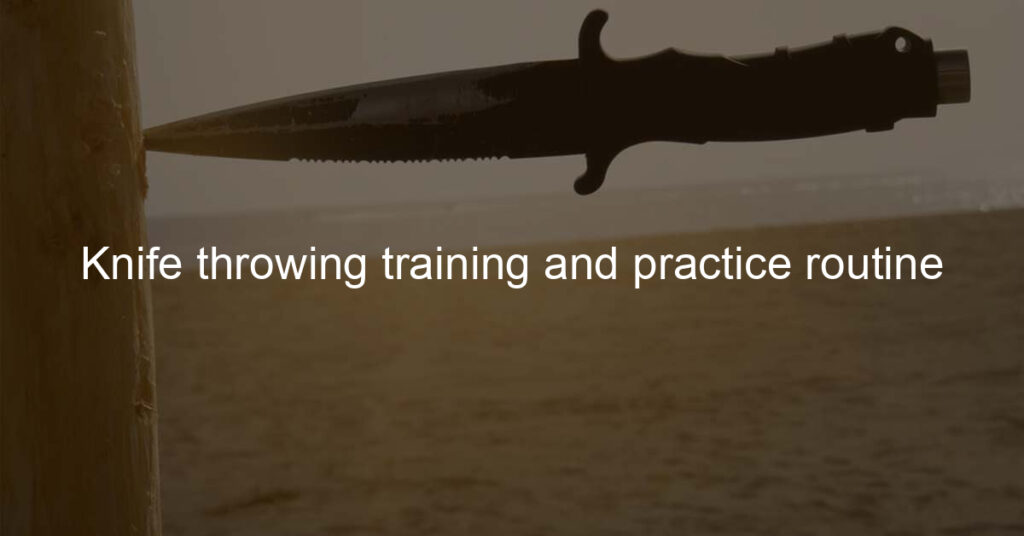So you want to learn how to knife throw? Or maybe you’re already pretty good at it and just looking for a training and practice routine to help you improve. Either way, you’ve come to the right place. In this blog post, we’ll cover everything you need to know about how to get started with knife throwing, as well as some tips and tricks for improving your technique. So let’s get started!
Can you practice knife throwing?
Knife throwing is an exciting and thrilling activity that people of all ages can enjoy. It’s a skill that may take some practice to master, but the feeling of accomplishment you get after each successful spin is worth it.
The idea of knife throwing might sound intimidating, but don’t worry – all you need are knives specifically designed for throwing, a good target to throw towards, and then practice! With regular practice, your arm strength and confidence in throwing will dramatically increase. So if you ever get bored or feel like trying something new and fun, consider taking up knife throwing as your next hobby!
How long does it take to learn knife throwing?
Learning the art of knife throwing is an incredibly rewarding experience but it can also be intimidating to get started. Depending on your existing skill set and how many hours you can dedicate to practice, the time it takes to learn knife throwing will vary.
It usually takes beginners between four to eight weeks to become proficient at basic knife-throwing techniques such as aiming for a target, accuracy, calibrating distances, and consistent rotation of knives in the air. However, mastering all the nuances and building a strong foundation can take well over several months of thorough practice and skill-honing which is essential if you want to progress further into advanced techniques like multiple throws or target juggling.
What are the basics of knife throwing?
Knife throwing is an exciting and potentially dangerous sport. It requires a steady hand, precision, and practice to ensure safety. To get started, a good quality throwing knife is recommended as this will increase the likelihood of success from your first throw. You also need to have an understanding of the grip you should be using when your blade leaves your hand.
Depending on the distance you’re trying to achieve with each throw, you’ll need to adjust your stance and grip accordingly. For beginners, it’s best to practice knife throwing at targets and distances of around 7 ft or less until they become more experienced before increasing their distance. Finally, always watch out for where other people are before launching a blade!
What can I use to practice knife skills?
If you’re looking to practice and sharpen your knife skills, look no further than a good-quality cutting board and some vegetables. You can use a wide variety of vegetables such as onions, potatoes, peppers, carrots, and celery to practice different slicing techniques.
The great thing about practicing vegetables is that their firm texture allows you to learn how to properly slice without needing a tough cut of meat or anything like that. After you’ve mastered slicing, move on to the more intricate techniques like julienne, brunoise, and chiffonade with basil or ribbons of carrot for instance. With the right tools and some patience, you’ll be chopping like a professional in no time!
What is the basic skill of throwing?
The basic skill of throwing can be an extremely useful tool for many athletic activities. Throwing is the act of propelling an object through the air with a certain amount of force, either to hit a target or simply for the act itself. It is not just limited to sports and can come in handy in simple everyday situations too.
For instance, when younger children are playing games like catch or frisbee they often rely on their ability to throw as this is a crucial part of the game. It also needs to be done accurately to avoid any potential injury due to people either being hit by the object or having it land too close to them. This is why mastering the throwing technique is essential if you want to use it effectively in any kind of sporting activity.
How can I improve my throwing skills?
There are several ways to improve your throwing skills, so don’t worry if you’re starting from scratch. To start, you should read up on the basics — hand and arm positioning, general techniques, and common mistakes. Once you have a basic understanding of the mechanics involved, start practicing!
Make sure that you set aside dedicated time for practice to focus solely on your aim and technique. You can do this solo or with friends for a little extra motivation. Make sure to vary the distance that you throw from and reward yourself for improvements in skill. In time, through practice and attention to detail, your throwing skills will improve drastically!
Conclusion
To sum it up, knife throwing is an incredibly fun and fascinating hobby that can leave you feeling proud of your achievements and wanting to keep pushing yourself further. It requires dedication and practice over a long time to perfect your technique, honing those skills to become a champion knife-thrower. Of course, safety measures must always be taken into account when participating in this type of activity for an enjoyable and safe experience. With the correct equipment, attention to detail, and commitment to learning the art of knife throwing, you will be able to sharpen your skills significantly as well as have some really fun times!







